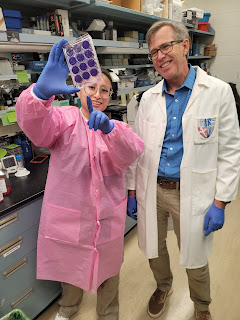USU Researchers Develop Potential Cure for Rabies Infection
Uniformed Services University researchers have developed a potential cure for rabies infection, offering hope for an effective treatment for human rabies
September 28, 2023 by Sarah Marshall
Researchers at the Uniformed Services University (USU) have made a significant breakthrough in the fight against the deadly viral infection rabies.
Department of Microbiology and Immunology, published a study Sept. 28 - World Rabies Day - in EMBO Molecular Medicine, along with scientists in their lab, that demonstrates an effective treatment for combating lyssavirus infection (rabies). The research team’s findings suggest that this single-dose treatment could be easily administered for symptomatic rabies.“Lyssaviruses are typically transmitted to humans by a bite or scratch from an infected animal, most commonly a dog,” said Schaefer. “These viruses then invade the nervous system of mammals, causing the disease called rabies. Although there are highly effective vaccines and post-exposure treatments for rabies, these interventions do not work once the virus reaches the central nervous system and neurological symptoms become apparent. Symptomatic rabies infection in humans is essentially 100 percent fatal.”
Currently, there is no validated treatment in humans that prevents death following symptomatic rabies. Although human rabies in industrialized countries is rare, there are about 60,000 deaths per year worldwide from rabies transmitted by dogs. Almost all human rabies deaths occur in poorer countries, where rabid dogs can be common and access to preventive measures is limited or absent. This harsh reality is especially significant for our nation’s military troops who often serve in regions around the world where encounters with rabid animals are a real and concerning risk.
The USU research team and their collaborators have previously demonstrated that a lab-made monoclonal antibody, called F11, can effectively block lyssavirus infections in lab cell cultures. In this current study, led by Emerging Infectious Diseases graduate student Celeste Huaman and Dr. Kate Mastraccio, the researchers looked to see if F11 would prevent rabies after lyssavirus infection. They tested this theory in mice using two distinct lyssaviruses: Australian bat lyssavirus (ABLV) and a strain of rabies virus called CVS-11. They expected the antibody to effectively block the viral infection at very early stages of the disease, before it replicated in the spinal cord and brain.
The researchers were surprised to find in this study, however, that a single dose of F11 was effective much later in the course of infection, reversing signs of the disease after they were already apparent. Remarkably, F11 actually prevented death induced by either ABLV or CVS-11, even when F11 was administered after the virus entered the central nervous system and was causing signs of neurological disease.
While low levels of the virus remained in those given the F11 treatment, levels did not increase and signs of rabies disease did not return over the course of this study. Ultimately, the researchers suggest that the F11 monoclonal antibody could prove to be a successful cure for human rabies.
Antiviral monoclonal antibodies like F11 are believed to work primarily through neutralization – binding to the virus and preventing infection of cells and tissues. However, monoclonal antibodies are not able to cross the blood-brain barrier (a physical barrier that prevents antibodies and other large molecules from entering the spinal cord and brain), meaning they can’t neutralize viruses that have infected the central nervous system. For this reason, the researchers were surprised to find F11 functioned as a therapeutic agent for lyssavirus infections already established in the spinal cord.
Through their investigations, the research team found F11 protected animals from lyssavirus infection by an action distinct from neutralization. Specifically, F11 dramatically changes the types of immune cells found in the brains of infected animals. In particular, the protective effect of F11 requires the presence of a type of immune cell, called the CD4-positive T cells. Overall, these results were unexpected because the F11 that was administered to animals through the peripheral blood – blood that is circulating through the body – caused major changes to the immune cells in their brains – even though F11 is blocked from entering the brain.
Taken together, these findings suggest that the F11 antibody, or similar antibodies, could potentially be translated into a treatment for humans infected with rabies. Considering most cases of rabies occur in rural areas in countries with limited medical resources, single-dose administration of F11 may represent a simple, easily administered therapy that could effectively reach these populations.
“If these findings can be generalized to other viral pathogens that target the spinal cord and brain, this work may have broad implications for treating many other human viral diseases of the central nervous system, which are currently difficult to treat and often result in high rates of fatality and/or life-long debilitation,” Schaefer said.



